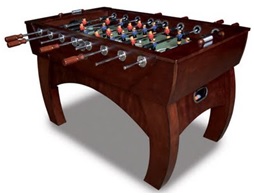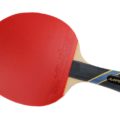
As is the case with any multiplayer game, the objective of foosball is to win the game against your opponent. However, reaching the ultimate goal of victory requires a clear and concise understanding of the basic rules of foosball. There are free throws, number of players, offensive players, defensive players, passing rules, bouncing rules, and a millions other things you need to consider. Understanding and abiding by the rules will ensure that you are following the parameters of the game that your gameplay is completely legal and that your forthcoming victory is rightly deserved. Read on for a quick overview of the basic rules of playing foosball.
1. Number of Players: A game of foosball is played as either one person versus one person or two people versus two people. In the case of two people versus two people, one of the members of each two-person team will control the defensive rod and the other will control the offensive rod, with players given the ability to switch between defensive and offensive positions at the next upcoming serve.
2. Starting the Game: The generally and universally accepted mode of starting a game is by flipping a coin. The winner of the coin flip is given their choice of two options to pick from: Kicking off first or picking their side of the table. After the initial kick-off, which is initiated by dropping the ball on the center of the table or by the ball being fed into the table slot, the subsequent kick-off is given to the team who conceded the last goal or point. Always ensure your opponent is ready by asking them prior to kick off and be mindful that the ball must touch two sets of 5 bar players before it can be considered playable for a pass or shot.
3. Time Limits: Respecting time limits is an integral part of playing foosball. When a player is in control of the rod, the ball must be ejected within 10 seconds on the midfield row or 15 seconds on the forward or defense rods. Be aware that time limits commence when the ball is in range of any players on the rod.
4. Out of Bounds Classification: Anytime the ball leaves the play area it is considered to be out of bounds. The foosball play area includes the surface of the table, the space directly above that surface, and the area spanning up to the tops of the sides of the cabinet. When the ball is out of these areas it is considered to be out of play or out of bounds. Even if the ball happens to rebound back onto the table, it is still considered as being out of play. Once the ball is classified as being out of bounds, the opposing team will be delegated as having the next serve, at which point the ball must touch two players before it can be passed or shot.
5. Dead Ball: A dead ball is deemed as such when it can’t be reached by any figure. In the case of an unreachable ball, the location of the ball is the determinant in how it is reserved. If the ball stops in a position where is between the middle 5 player rods or bars, the ball is simply reserved midfield by the team that conceded the last goal. However, if the ball stops behind either of the midfield rows, it is reserved using the closest defending player in the nearest defensive area. Again, the ball must touch two players on the board before it is to be passed or shot.
6. Passing: Different from a “dead” ball, a “pinned” ball that is stopped or trapped against a wall or cabinet surface cannot be passed without initially touching a second player. More explicitly, the ball cannot be passed directly from the forward rod to the midfield or from a defensive position to the midfield. Additionally, the ball may only touch the sides of the cabinet twice while midfield. In any event, the ball must be in motion for any pass attempt to be considered legal.
7. Fouls: A foul in foosball is classified as any unsportsmanlike conduct and includes the following: Intentionally distracting an opponent, reaching into the gameplay area without permission from the opposing side (see below), jarring or moving the table to affect the integrity of the ball and its movement. Jarring or moving the tables with your body or by slamming the rods are both illegal and considered to be a foul. The penalty for committing a foul is ceding possession of the ball to the opposing team on the nearest rod.
8. Reaching into Play: Reaching into play is a move that is allowable when circumstances permit and when expressly agreed to by the opposing team. Without permitting circumstances or the permission of the opposing team, reaching into play is illegal and will result in a penalty for the offender. The penalty enacted is dependent upon which team had possession of the ball at the time of the offense. If the ball was in the possession of the team who committed the offense, the opposing team will be awarded the next serve or kick-off. Conversely, if the team who committed the offense did not have possession of the ball, the team in possession will score an automatic goal.
9. Spinning: Spinning is typically illegal in foosball (unless previously stated before the commencing play and is considered to be an ultimate faux pas in gameplay. It is unsportsmanlike and unprofessional to engage in spinning unless expressly agreed to beforehand. Spinning is typically defined as rotating the rods more than 360 degrees before or after striking the ball. This aggressive action is done with the intent of scoring a goal and is in stark contrast to the more normative style of play exhibited in foosball with the maneuvering of the wrists through flicking and tempered strokes.
10. Game Length: The length of a foosball game is typically agreed upon beforehand by establishing a predetermined amount of goals that need to be won (ex. 5, 10, 11). Other common options in establishing game length are whoever gets to 5 goals first or whoever gets the “best out of” 5 games.
11. Switching Positions: Switching positions during foosball is dependent on the number of players involved. When in doubles play, each member of the two-man team will operate either the offensive or defensive rods and only be permitted to switch positions during ball serves or timeouts. Conversely, during singles play, switching positions occurs after each match is completed.
12. Scoring and Bounce-Outs: Any player on the field is permitted to score a goal and if the ball happens to bounce back outwards from the goal, it is still considered legal. To be succinct, anytime the ball enters the goal, it is considered a goal, even if it happens to bounce out of the goal area. Anytime a goal occurs, gameplay is restarted with a kickoff at midfield to the team that previously conceded the goal.

